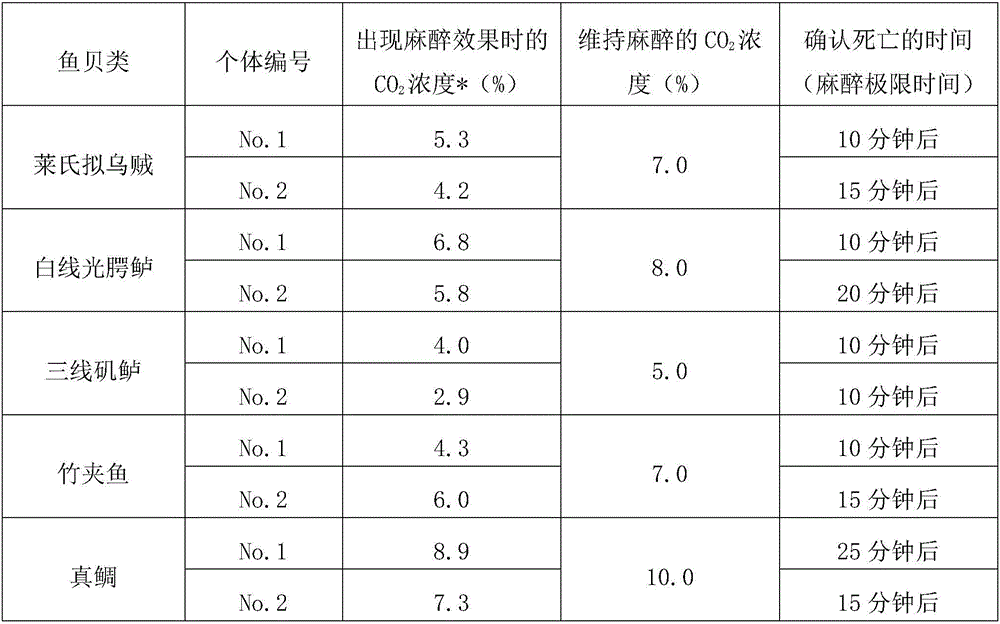Method and device for anesthetizing fish
A fish and shellfish, oxygen technology, applied in fish farming, medical science, animal husbandry, etc., can solve the problems of limited practicality and use of anesthesia methods, and achieve the effect of safe anesthesia
- Summary
- Abstract
- Description
- Claims
- Application Information
AI Technical Summary
Problems solved by technology
Method used
Image
Examples
Embodiment 1
[0039] "Example 1: Confirmation of the anesthesia limit time for carbon dioxide anesthesia of fish and shellfish at a water temperature of 20°C"
[0040] It is well known that when fish and shellfish are anesthetized with carbon dioxide at the water temperature (about 20°C) at which fish and shellfish are usually treated, the fish and shellfish will die in a very short time even under the condition of saturated dissolved oxygen. The limit time of anesthesia was confirmed experimentally. The types and individual numbers of the fish and shellfish used in the experiment are shown in Table 3. The water temperature in the experimental 700L water tank was adjusted to 20°C, and the dissolved oxygen (DO) in the seawater in the water tank was kept in a saturated state by using a common air pump and an air stone. In the state of saturated dissolved oxygen, carbon dioxide is passed into the water, and the concentration of dissolved carbon dioxide is increased at a rate of 0.5% per minut...
Embodiment 2
[0046] "Example 2: Confirmation of the concentration of carbon dioxide at which anesthesia occurs in fish and shellfish"
[0047] The species and individual numbers of the fish and shellfish used in the experiment are shown in Table 6. Adjust the water temperature in the 700L water tank for the experiment to 20°C, and while using the micro-bubble generating device to continuously supply the micro-bubbles with the particle size distribution shown in Table 5 into the water tank, carbon dioxide is introduced into the water at a rate of increase per minute. A rate of 0.5% increases the concentration of dissolved carbon dioxide to a level that would anesthetize fish and shellfish. The start of anesthesia was evaluated when it was confirmed from the monitoring camera that the swimming action stopped and the body movement stopped except for the breathing movement of the gills. Afterwards, when the carbon dioxide concentration reaches a certain degree higher than the carbon dioxide c...
Embodiment 3
[0055] "Example 3: Verification experiment of long-term anesthesia by carbon dioxide"
[0056] Five three-line sandpipers weighing about 450 g were used in the experiment. Adjust the water temperature in the experimental 700L water tank to 20°C. While continuously supplying microbubbles with the particle size distribution shown in Table 5 into the water tank using the microbubble generator, pass carbon dioxide into the water to increase the concentration of dissolved carbon dioxide. to 5% to anesthetize three-line sea bass. When the concentration of dissolved carbon dioxide reached 5%, it was confirmed by surveillance cameras that all individuals stopped swimming, and their body movements stopped except for the breathing movement of the gills. Thereafter, anesthesia was performed for 20 hours while maintaining a carbon dioxide concentration in the range of 5.0-4.5%. After anesthesia, inject oxygen to drive out the carbon dioxide in the tank, and slowly reduce the concentrati...
PUM
 Login to View More
Login to View More Abstract
Description
Claims
Application Information
 Login to View More
Login to View More - R&D
- Intellectual Property
- Life Sciences
- Materials
- Tech Scout
- Unparalleled Data Quality
- Higher Quality Content
- 60% Fewer Hallucinations
Browse by: Latest US Patents, China's latest patents, Technical Efficacy Thesaurus, Application Domain, Technology Topic, Popular Technical Reports.
© 2025 PatSnap. All rights reserved.Legal|Privacy policy|Modern Slavery Act Transparency Statement|Sitemap|About US| Contact US: help@patsnap.com



